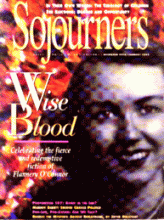The angel is in a hurry. She is tense with urgency and lacks the dignity generally attributed to angels. Caught mid-stride, she leans forward, as if straining against the wind. Her gown whips about her ankles. Her right arm is extended; in her hand is a burning candle, thrusting light into darkness.
The small figure-about 8 inches high-is flat, a silhouette, cut from a thin piece of pine. This angel has become the symbol of Raphael House, a shelter for homeless families located on the edge of the Tenderloin district in San Francisco.
Every evening, after the children have been bathed and readied for bed, they come together with the parents for story time. Seated on children's chairs or sprawled on the large, floppy floor pillows, children and parents settle in to hear a volunteer tell a story. The storyteller suffers patiently the interruptions of giggles, gasps, and applause.
When the story is finished, the storyteller takes the candleholder shaped like a running angel. She lights the candle and begins to sing, "See the little candle burning bright." Children and parents join in, "How I love to see its light." The storyteller, candle in hand, leads children and parents in a rag-tag procession toward their bedrooms. The procession stops at the door of the first room and a mother and three children enter. The procession continues: "See the little candle burning bright." In this way families are escorted to their rooms each night.
Like the angel, the procession lacks polish and dignity. While some children sing, others whine and complain about going to bed, or some sneak out of line and hide in the bathroom. Nevertheless, despiteor perhaps because ofits raggedness, the ritual speaks of the heart of Raphael House. Women, men, and children whose days are haunted by uncertainty, pain, anger, and despair come together to close the day in an atmosphere of love, nurture, security, and peace.
Read the Full Article
